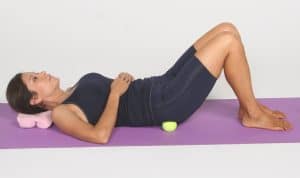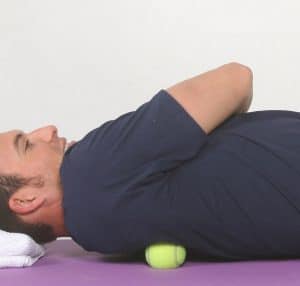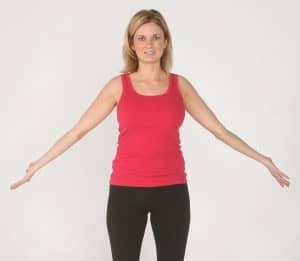When people think about posture, they typically remember a parent or teacher telling them to stand up straight and stop slouching.
However, posture is not just about the way you stand or sit. Posture refers to the way all the joints in our body are stacked on top of each other to form either a strong and stable structure…or a crumbling mess.
I’m sure you remember the old song, “the knee bone’s connected to the thigh bone, the thigh bone’s connected to the hip bone…” and so on. This fun little song actually explains exactly how poor posture affects your lower back and can cause pain–and why you need to improve your posture.

How Your Bad Posture Is Causing You Pain
Because most of us spend time seated for the majority of the day, our muscles become weak. Therefore, when we try to stand, walk, or move, our bones tend to collapse instead of being pulled into alignment by strong muscles.
Related: 6 Great Exercises To Gain Muscle
For example, most people overpronate at the feet — which means your feet collapse inward. This collapsing of the feet causes your ankles, shins and thighs to collapse inward on top of the feet…which in turn affects the pelvis, then the base of the spine, which can lead to back pain.
But the posture problems don’t end there. Poor seated postures can also cause lower back pain in another way, especially if you spend most of the day seated either at a computer, driving to work, or slouching on the couch watching television.
That’s because these postures cause your upper back and shoulders to round and your head to jut forward. These changes in your upper back and neck place extra stress on your lower back. Therefore, poor posture in your feet, ankles, legs as well as in your upper back, shoulders and neck can all lead to lower back pain.
Related: 7 Surprising Causes Of Back Pain
So what can you do to improve your posture and prevent lower back pain? Adopt these simple techniques to improve both your standing and seated postures.
How To Have Better Posture (And Get Rid Of Back Pain)
1. Choose better shoes
Shoes with heels (even the slightest heel, such as those on running shoes) tip your body forward when you are standing or walking.
This continual, forward-leaning posture can put stress on your spine and lead to lower back pain.
Try to select shoes that have no heel or minimize the amount of time you spend in high-heeled footwear.
2. Vary your posture
Contrary to popular belief, there is no ideal sitting posture. Our body is designed to move and be dynamic.
Related: 5 Ways To Have Good Posture
As such, stand up regularly throughout the day and take mini-breaks away from your computer to help straighten out your hips and spine and eliminate long-term posture problems caused by excessive sitting.
3. Massage sore muscles
You can massage the muscles around your hips/lower back and shoulders/upper back to decrease tension and improve posture.
Here are two easy (yet extremely effective) self-massage techniques you can do with a simple tennis ball.

Lie on the floor on your back with your knees bent. Place a tennis ball under the right side of your butt. Scoot your body up and down and from side to side to move the ball to any sore spots you find.
When you find a sore spot, keep the ball there for up to 20 seconds until the tension releases. Then, move to the next spot. Do this exercise for each buttock for one to two minutes once per day.

Here’s another one: lay on the floor with your knees bent and head resting on a pillow. Pull one arm across your chest and place a tennis ball under the shoulder blade of that arm. Find a sore spot and hold for 20-30 seconds to the release tension. Then, move the ball gently to another spot. Perform at least once per day on both sides of your body.
Related: 4 Self Massage Techniques You Can Do Anywhere
4. Stretch tight muscles
The muscles of the hips, torso, and shoulders can get chronically tight throughout the day as a result of prolonged sitting. Take short breaks throughout the day and stretch in the doorway (see below) to help improve your posture and decrease back pain. Here’s a good stretch to try.

Step your right leg through a door frame and keep your left leg back as you reach up with your left arm to the door jam. Tuck your butt and hips under on the left side while still keeping your left leg straight and left heel on the ground.
You should feel this stretch in the front of your left hip/leg, left calf, and abdominals. Repeat on the other side. Do this for 30 seconds on each side once per day.
Related: 5 Reasons To Start Doing Bedtime Stretches
5. Strengthen weak muscles
Strengthening the muscles of your upper back and shoulders can help reverse the damage done to your posture from sitting all day.
Perform the exercise below at least a couple of times a day to improve posture and help your lower back feel a lot better.

Stand up and take your arms out to your side and slightly behind you. Rotate your palms upward. Squeeze the shoulder muscles in the middle of your back to help pull your shoulder blades and arms back. Do not shrug your shoulders. Hold this position for 10 -15 seconds. Do two to three repetitions twice a day.
Related: The 6 Best Workouts To Gain Muscle
The Takeaway
Being aware of the activities that cause you to slouch and integrating the simple strategies detailed above into your daily routine can help improve your posture and decrease the likelihood you will experience lower back pain.
***********************
 Justin Price is an award-winning pain relief exercise expert who has taught his revolutionary program, The BioMechanics Method®, to countless health and fitness professionals in more than 30 countries. The high demand for specialists trained in his unique methods has prompted Justin to write a series of “DIY” pain-relief books for the general public.
Justin Price is an award-winning pain relief exercise expert who has taught his revolutionary program, The BioMechanics Method®, to countless health and fitness professionals in more than 30 countries. The high demand for specialists trained in his unique methods has prompted Justin to write a series of “DIY” pain-relief books for the general public.
Featured photo by Dave77459
Other photos provided by author
